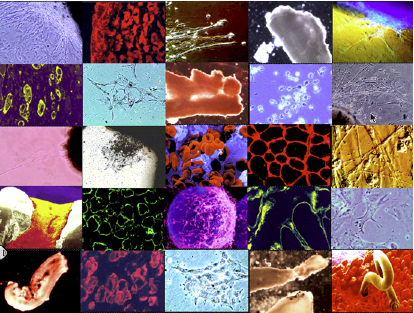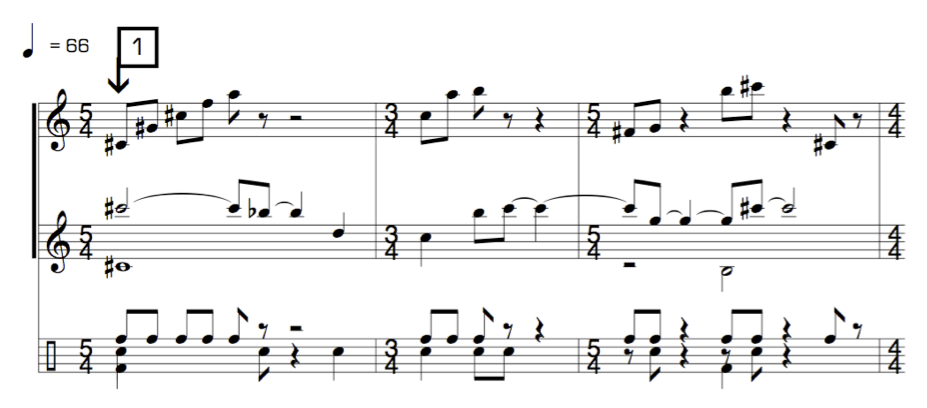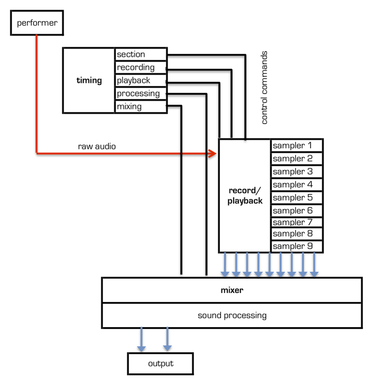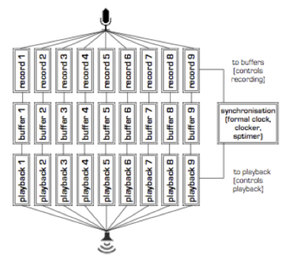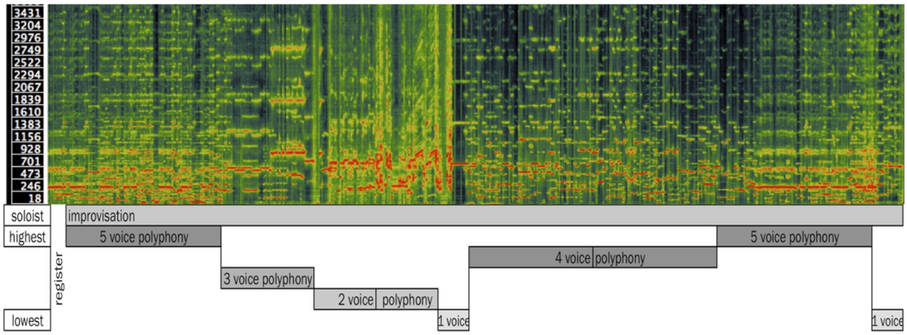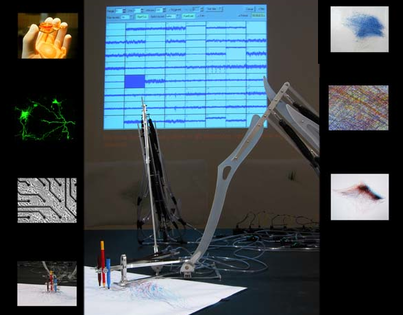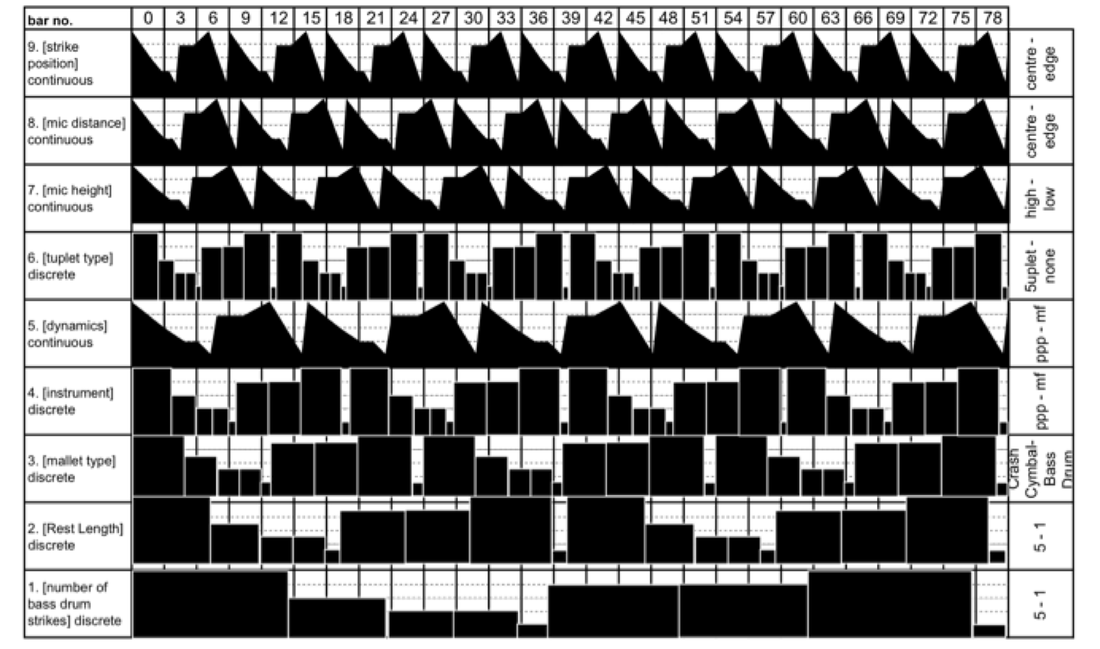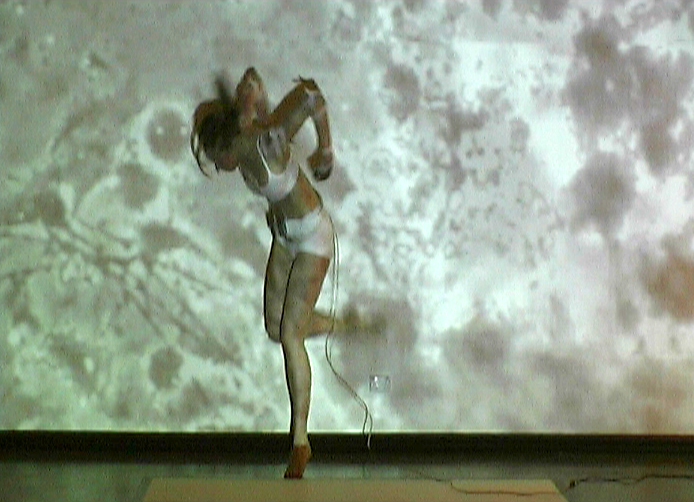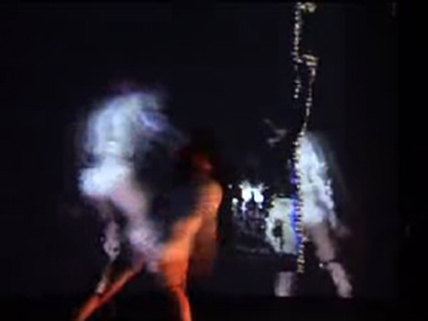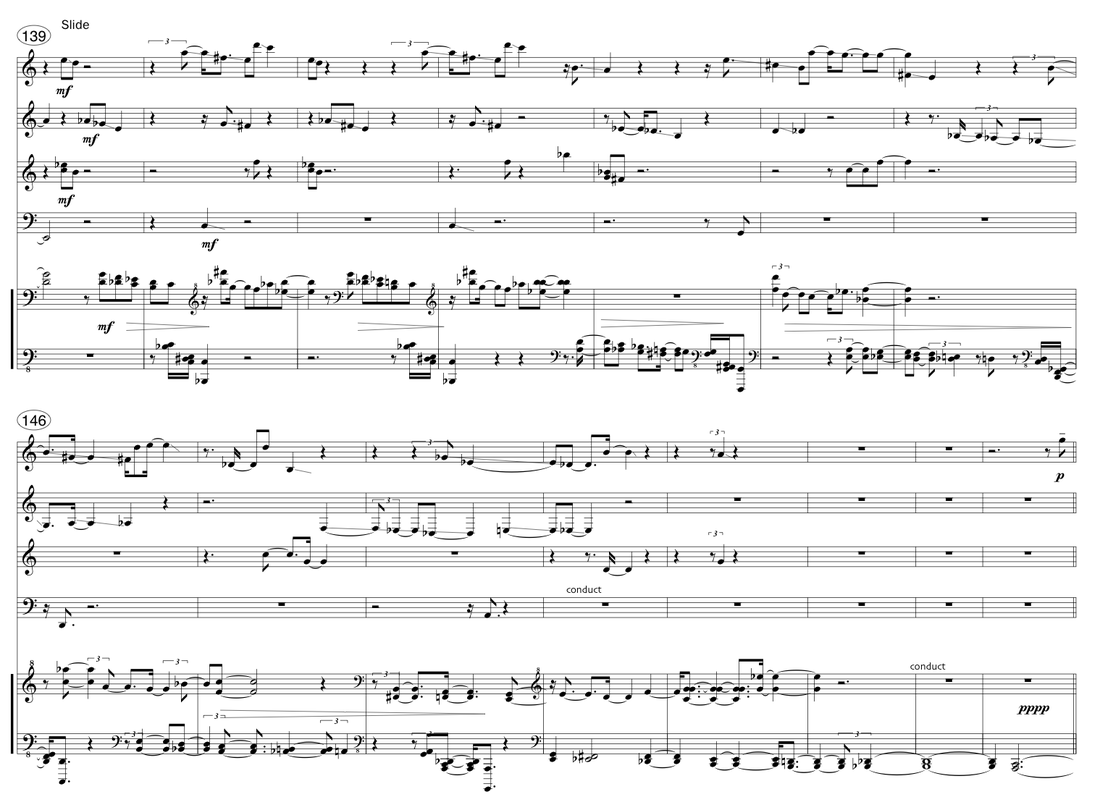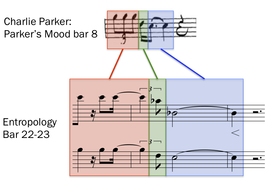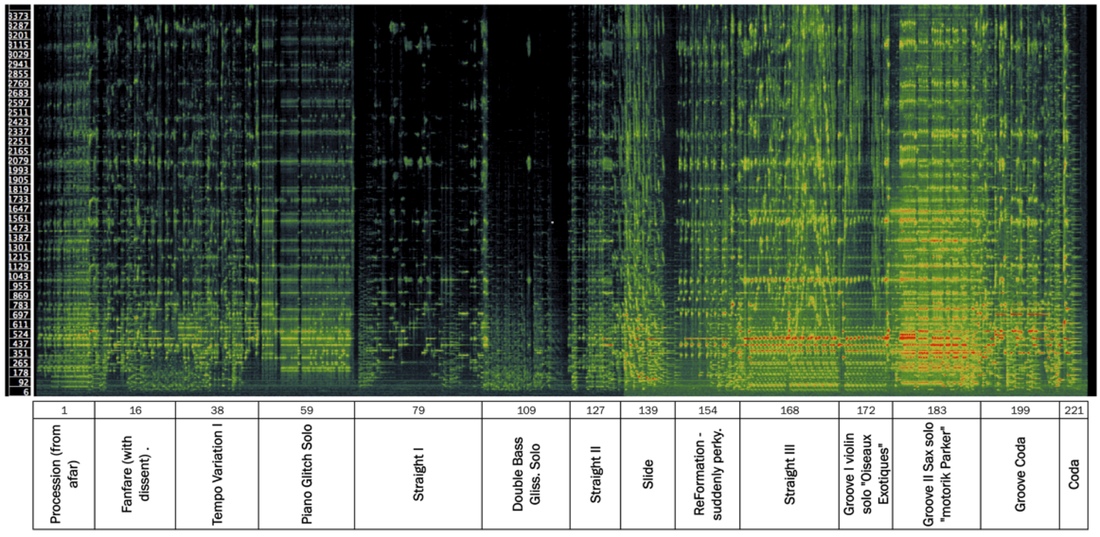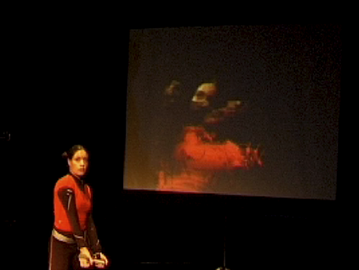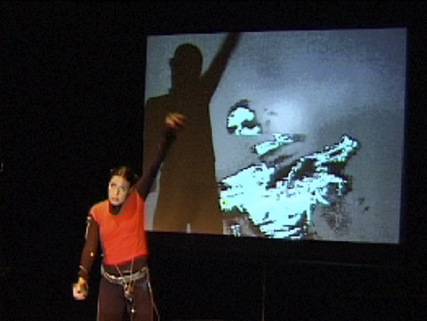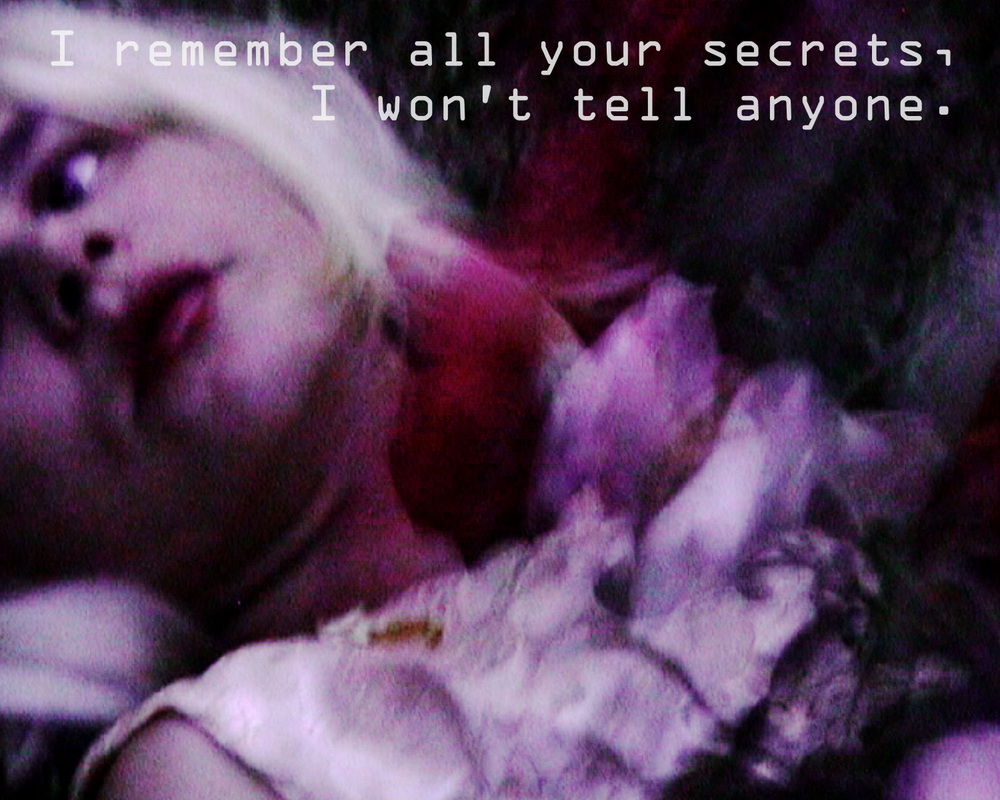86 Scan 2002 MIBURI, interactive electronics and video 6m
|
Scan was created for the skadada company’s dancework of the same name. It used images provided by Tissue Culture and Art (Oron Catts, Ionat Zurr and Guy Ben-Ary), audio samples by John Patterson and was used as the opening sequence of a larger work about surveillance and alienation. In the interactive component of scan, 25 microscopic images were accessed using Image/ine’s extremely rapid response time to give the allusion of a hyper-accelerated examination of slides by an electron-microscope.
|
85 Phase-shift 2002 tenor sax and drums 4m84 Lizard Sole 2002 tenor sax and drums 9m |
These two works were created for the improvising duo HEDKIKR. They were based of musical material from my earlier ensemble works Phase Matrix, and Leo Szilard. Phase-shift utilises a system of cross fingerings to condense the original five temporal layers (for at least part of its duration) onto the body of the saxophone. Listen here and here.
|
83 offRamp 2002 tenor sax and drums 8m

At the heart of offRamp is a nine beat melodic kernel, containing every beat subdivision from a single beat to a quintuplet (five in the time of one). Tempi can be derived from these subdivisions - for example if there are 36 single beats (MM.=36) per minute then there will be 180 quintuplet beats (MM. = 180) per minute.
The tempi implied by the tuplets provide exit points (off ramps) into different tempi. The melodic kernel also begins of a different beat in each of the nine tempi/sections, so that the same material is viewed each time from a different perspective in both its physical and temporal orientations. offRamp was written for a HEDKIKR tour of the US freeway system. The concept explored in offRamp was also used in its sibling work Exit Points [2003]. Listen here.
82 Between the Lines 2002 tenor sax and drums 6m
|
Between the Lines has a multilinear structure. The performers are provided with a score comprising three simultaneous alternative pathways. The performer must, at particular nodal points in the work, chose to perform one of the three lines, to improvise or to remain silent. The three lines are distinguished by density, register and function: line one is arpeggiac, line two melodic and line three underpins harmonic movement. The work was written for the duo HEDKIKR, comprising tenor saxophone and drums. The score excerpt in to the right shows two upper staves in which the lines to be played by the saxophone are notated, and a lower stave in which all three lines are notated for the drummer. The concept explored in between the lines was also used in its sibling work Parallel Trajectories [2003]. Listen here.
|
|
81 Molly Sweeney 2002 Violin, voice and electronics CD
80 the changeling 2002 tenor sax, drums and electronics on CD
79 Splice 2002 instrument and electronics 6m
|
|
Splice employs synchronised live sampling of the soloist to impose a formal structure on a live improvisation. It is an example of an encoded 'meta-music' - a compositional map that is without contents until a live performer adds them. The soloist's sounds may be stretched, altered in pitch, echoed or recorded only to re-emerge later - techniques similar for example to those found in a conventional notated composition – with the exception that they occur in realtime. Splice sculpts all sounds into the same structure regardless of whether they are melodic, noise or even silence, generating a novel instantiation of its structure in each performance.
The performative model for the work is simple and typical of works of this type: a live soloist; a microphone recording the soloist’s performance; a computer processing the recorded audio in real-time; and speakers projecting the soloist’s performance and the processed audio. The final component of this arrangement is the soloists’ interaction with the computer’s manipulation of their own performance (See the Figure below). |
|
Splice’s formal strategy is to record, manipulate and playback live audio from a soloist’s improvisation, creating a structure that is based upon elements typical of musical works, such as those noted by Dannenberg and Hu:
Splice uses nine separate recording and playback modules, each restricted to a different buffer size (See Figure 84). The largest buffer allows for nine seconds of audio to be recorded and the smallest allows for just one second. The synchronisation of the recording and playback by the splicer modules is controlled independently according to a predetermined scheduling.
The audio processing in Splice creates an emergent formal structure: the same “cypher” structure previously discussed. It is a referential structure, but only in the sense that the sampled materials have been recently played by the live soloist. The structure is articulated principally through changes in the number of voices of polyphony in each section and the average frequency of the sample playback. |
|
|
As in Delicious Ironies, the splicer modules do not function simultaneously throughout the entire piece. They are turned on and off according to the work’s “formal clock”. The activation and deactivation of the splicer modules generates changes of density in the overall resultant texture. Differences in the properties of each splicer module and the number of splicer modules that are active at any point create changes in polyphony from one section to the next.
|
|
The inherent structure is empty until the introduction of audio from the soloist’s performance. The contents of the formal structure are therefore contingent upon the sounds emitted by the soloist, and this results in openness of the work in terms of sonic content. The performer’s role is dual, in that they provide raw material for the computer, but additionally interact, responding to the computer’s audio output. The timing and nature of the computer’s processing is not predictable by the performer. However, a timer on the computer screen steps through the 27 units of the work’s duration, and gives the performer a general indication of the state of the computer’s progress through the structure.
Splice has been performed with a solo saxophone, guitar, toy instruments, voice and drums. A schematic of the resulting structure is shown in contrast to a spectrogram of a performance of the work in below. Listen here. |
|
.
78 Still-life with visitations 2002 sop, alt, tenor sax, tpt, tbn, tba, vibe, kit, org, pno, vln I and II, vla, vcl, db 9m
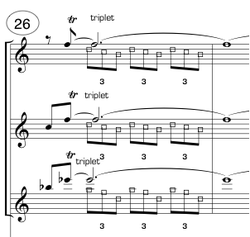
Still-life with Visitations was written for The Collective. As the title suggests it comprises a static textural foundation upon which various kinds of musical events manifest themselves: a kind of sound-painting moving in time. The ‘visitations’ are comprised of related musical material that is modally transfigured and usually moving at a different tempo, suggesting openings or recollections of other times/configurations. They were intended to suggest openings or recollections of
other times/configurations, in a manner similar to Stockhausen’s “Einschub”
(Maconie 2005 p. 195) technique.
The work has a uniform meter and slow tempo (mm. 42), upon which harmonic material, forming the textural foundation, is stretched both by transposition to create denser sonorities and temporally to produce diverse rhythmic material that does not reinforce the underlying pulse. The “visitations” are differentiated from the foundation by their contrasting rhythmic unison. This procedure relies less heavily on the disjunction of multiple parameters, and arguably results in something other than a sense of “block form” structure, a multilinear texture in which a continuous form is superimposed upon by contrasting blocks of material. Listen here.
The work has a uniform meter and slow tempo (mm. 42), upon which harmonic material, forming the textural foundation, is stretched both by transposition to create denser sonorities and temporally to produce diverse rhythmic material that does not reinforce the underlying pulse. The “visitations” are differentiated from the foundation by their contrasting rhythmic unison. This procedure relies less heavily on the disjunction of multiple parameters, and arguably results in something other than a sense of “block form” structure, a multilinear texture in which a continuous form is superimposed upon by contrasting blocks of material. Listen here.
77 Dream Tigers 2002 Voice, Piano, Bass and Electronics 16m
76 hypochondrium 2002 saxophone and delay 7m
75 meart/mesound 2002 saxophone/electronics, drums and video
|
Installation: Guy Ben-Ary, Philip Gamblen, Iain Switman, Oron Catts, Ionat Zurr, Dr Stuart Bunt, Dr Steve M. Potter, Thomas De Mars and Alexander Shkolnik.
Meart (AKA Fish+Chips) is an installation/organic art creator made by the team at SymbioticA. The movements of its pneumatic arms (and pen wielding fingers) are controlled remotely by electrical signals from a culture of fish neurons located in Atlanta. The drawings it creates have for some, a haunting primal quality, and for others they are like a foretaste of communications with alien life. We were immediately struck by the musical quality of the pneumatic blasts that provide a compelling soundtrack to the unfolding image. |
74 interXection 2002 drums, microphone and ring modulator 9m

interXection for Drum Kit and Ring Modulator set out to highlight the analogy of the microphone as an audio microscope by magnifying barely audible sounds from the drum kit and processing them through a Ring Modulator. The intention was that the Ring Modulator would bring the source sound’s component harmonics into relief in a way that is analogous to a colour imaging microscope’s rendering of biological samples.
|
An overarching structure is used to to determine a number of parameters including the percussionist’s tempo, roll speed, instrument, mallet type, accent, dynamics, rest, note length and strike position on the current instrument, as well as the vertical and horizontal coordinates of the microphonist’s microphone in relation to the percussionist’s current instrument.
This microphone part, essentially notating two 'vectors', resembles the graphic interface for automation for Pro-tools© effects inserts. InterXection notates the polytemporal processes of the computer components of Delicious Ironies and Splice. Importantly however the polytemporal levels control individual parameters that are fused together by the performer through the score, resulting in a conjunctive surface. The polytemporal levels manipulated both in a discrete and a continuous manner as illustrated in the Figure to the left. Listen here. |
|
73 Microphagia 2002 saxophone/electronics, drums and MIBURI, interactive electronics and video 9m
|
Images - Yuben Moodley and Guy Ben-Ary Interactive Video - Lindsay Vickery
Microphages, white blood cells, are the body’s cleaning crew disguised as PacMen. TCA’s movie shows them in action scrubbing up a culture of fish neurons. |
The MIBURI acts as the controls on a microscope allowing the dancer to zoom in and out on the movie and to move the position of the frame in two dimensions.
|
72 cytoblasty 2002 MIBURI, drums, saxophone, interactive electronics and video 12m
|
The sound samples are taken from previous HEDKIKR performances, transforming the dancer into a virtual duo partner in a HEDKIKR double duet.
|
Interactive Video+Audio - Lindsay Vickery, Images – Katriona Lloyd and Guy Ben-Ary
Cytoblasty gives the MIBURI suit control over both sound and video components. A live video signal allows the MIBURIST to mix images and Quicktime movies of microscopic material with her own live movement. |
71 fantastic voyage 2002 saxophone/electronics, drums and video 27m
Fantastic Voyage draws its title from the 1968 film about a secret US military organization that miniaturizes a medical team and injects it into the body of a comatose scientist from a shadowy evil foreign power. Our version features images provided by famed mad Sci-Artists Tissue Culture and Art (Oron Catts, Ionat Zurr, Katriona Lloyd and Guy Ben-Ary) and incorporates biological/ endoscopical footage that literally takes you inside the saxophone and drums.
5. SNARE 6. STRANGE TIDES 7. ORBIT 8. END CREDITS
|
1. TITLES 2. SKINRIDE 3. KEYHOLE 4. TWITCH
The opening TITLES image is of a cell-sculpture created by TCA; SKINRIDE is principally comprised of endoscope images of the drum kit; in KEYHOLE the endoscope visits the interior of the saxophone and saxophonist; TWITCH views a variety of assemblages of mouse cardiac cells – their sole purpose is synchronous pulsing; SNARE again takes a very close look at the snare drum’s underside; STRANGE TIDES traces the ebbs and flows of a culture of fish neurons; a colour imaging microscope provides the visuals for ORBIT; the final CREDITS unfurl over a close-up of the back of a rat’s eye. (ok, we lied about the diplomats)
|
70 entropology 2002 vln, a. sax., db, vibes and pno 11m
|
The interest in re-exploring and recontextualising the music of Charlie Parker is a theme that has run through my music, and includes the works Savoy Trifle (1986), A-Synchronous Au-Privave (1989) and Chase the Bird (1991). These two works continue that preoccupation. In Entropology, reflecting on the fact that for almost all of us Parker's legacy has come only from recordings, I set about trying to transform a written transcription of the work Parker’s Mood, through the distorting mirror of simulated LP record and CD-like glitches - blips, scratches, hung notes, failing motors and so on. Figure 68 shows one of these passages, the “slide” section, simulating the slowing down of a record player through expansion note and rest durations, gradual downward transposition and glissandi.
In addition to temporal stretching, the single line of Parker’s transcribed solo was subjected to a process of interval expansion, similar to that employed by Stockhausen in his work Mantra (1970) (see Maconie 2005 p. 331). The Figure below shows an example of both of these techniques from the score. |
|
Entropology was constructed in an unusual manner. The original Parker solo was transcribed onto a sequencer and then pitch was manipulated to create multiple transformed versions. This material was then temporally altered by applying radical accelerandi and ralentandi to the MIDI file. The altered file was then recorded into a second sequencer, at a fixed tempo of 120 bpm. This resulted in “written out” tempo changes notated in terms of note elongations and compressions, allowing the scoring of simulated polytemporal textures. The resulting materials were then “collaged” into a structure, quite removed from the original source. Entropology is more independent of its referent material than my earlier Parker-based works, in that the distortions are more severe, rendering the source material more obscure.
|
The Figure below shows the formal structure of Entropology in conjunction with a spectrogram of a performance of the work. The section titles are taken from the score and reflect the reference to simulated LP record and CD-like glitches, mentioned above. The “piano glitch solo”, the sudden loss of speed in the “double-bass gliss. solo”, the “slide” section and the two groove sections – in which soloists are accompanied by a repeating “locked-groove” accompaniment are all examples of the nonlinear fragmentations employed in this work. Listen here.
69 your sky is filled with billboards of the sky 2002 MIBURI, interactive electronics and video 9m
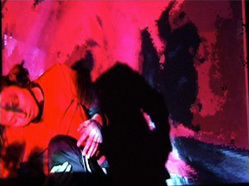
your sky is filled with billboards of the sky [2002] was developed for performance at the Real, Electronic and Virtual Instruments (REV) festival at the Brisbane Powerhouse in April 02. At the centre of the work is the MIBURI-clad performer interactively controlling all sound and video from her movements. (The MIBURI is a body-suit fitted with electronic sensors - like wearing an electronic keyboard). The dancer's gestures are translated in real-time by the MIBURI's sensors to control all of the musical elements you hear and also 'mix' the video component including a 'live' camera feed of the performance itself. Thematically, your sky is a sibling work to my song cycle songs of [virtual] love+war [1998]: perhaps a more abstract exploration of the same themes of identity in the context of a world increasingly comprised of simulated experiences. In this work the performer exists in a loop in which she is called upon to respond authentically to an environment almost entirely under her own control.
|
The interactive nature of the technology used in your sky opens the possibility for an open-ended non-linear formal structure, but in this version a mix of improvisation and predetermined structure was applied. The determined formal structure rested on three principal sections: Breath, Text and Exterior each a different Image/ine Preset. your sky used a live video feed for the bulk of the performance. A brief explanation of the Breath section will serve to demonstrate the degree of image control achieved.
In Breath, the Layers were arranged: Foreground: video, Background: QuickTime Movie and Displace Source: buffer. A large number of parameters were assigned to the MIBURI: Note number: Buffer displace angle (the maximum amount the image can be twisted on a central axis); Note Velocity: Buffer Frame pan ‘x’; Controller 1 : Buffer Frame Size as well as image hue/saturation and the degree of Keying between Layers; Pitchbend: Buffer Frame pan ‘y’ and its displace amount (how much the image can is twisted on a central axis within the ‘displace angle’). The bender also determined the luminousity of the Video Input. |
68 a throw of the dice 2002 instruments with MIBURI, interactive electronics and video 10m
|
Perth digital artist Vikki Wilson initiated this project concerning the serial killer 'still at large' in the urban family paradise of Perth. The work highlights the contrast between the city's naïve sun-bathed exterior and the dark reality of continued disappearance and murder of young women. The work also seeks to highlight the ambiguities of modern society’s simultaneous repulsion and fascination (as evidenced by 100s of Hollywood movies) with serial killing.
The images are by Vikki Wilson and the text by Erin Heffron and were first used in their installation a throw of the dice can never abolish chance [2000] . In this live performance version of the work the juxtaposition of images is made by a live performer using the MIBURI MIDI jump suit as a kind of ‘all-body’ VJ console. The central concept of linking the formal structure of the piece to its content (the horrifying randomness of serial killing) is maintained in this version through the use of a MAX patch that selects audio samples according to an unpredictable pattern. Listen here. |

